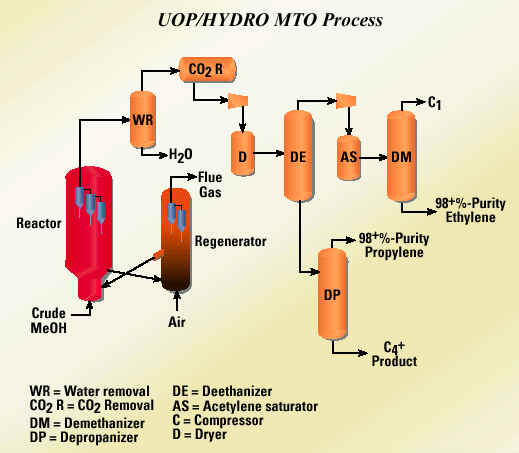
Egyptian Government
Approves Methanol-to-Olefins
The Egyptian government has approved Eatco
Petrochemical’s (Cairo) $1.4-billion olefins and
polyolefins project at Damietta, Egypt. Eatco says it is looking
for partners for the project, which will use a new methanol-to-olefins (MTO) technology developed by UOP and Norsk
Hydro. Eatco will convert methanol to ethylene and propylene,
which will be supplied to plants with capacity for 300,000
m.t./year of polyethylene and 200,000 m.t./year of polypropylene.
Eatco says Dow Chemical, Chevron Phillips Chemical, and Basell
are competing to supply polyolefins technology. Eatco adds that
it is close to appointing a financial advisor.
The MTOTM methanol to olefins process, developed by UOP and HYDRO of Norway, provides an economical means to convert methanol to olefins, primarily ethylene and propylene. Ethylene and propylene are in increasing demand worldwide and have significant financial value in the marketplace. With its higher yields, the MTO process is more economical than older technologies for indirect conversion of methane to higher value products.
The MTO process plays a key role in converting natural gas into olefins. The first step in that process, converting natural gas to methanol, has been available to the industry for some time. The second step, transforming the resulting methanol into olefins, is now available via the MTO process.
UOP/HYDRO MTO PROCESS
METHANOL TO OLEFINS CONVERSION
INTRODUCTION Changing natural gas into olefins is a two-step process
| The first
step, converting natural gas to crude methanol, has been
available to the industry for some time. The second step,
transforming the resulting methanol into olefins, has
recently been introduced by UOP and HYDRO of Norway. The
UOP/HYDRO MTO (methanol to olefins) process provides an
economical means to convert natural gas to olefins. The
UOP/HYDRO MTO process primarily converts the methanol
into ethylene and propylene. Ethylene and propylene are
in increasing demand worldwide and have significant
financial value in the marketplace. UOP and HYDRO have
developed the UOP/HYDRO MTO process for license to
customers worldwide. Other technologies for indirect conversion of methane to higher value products do exist. These processes have lower yields than the UOP/HYDRO MTO process and are, therefore, less economical. The UOP/HYDRO MTO process offers: |
|
| ・ | Exceptional value for direct conversion of methane to polymer-grade ethylene and propylene. |
| ・ | Direct use of ethylene and propylene in chemical-grade products with greater than 98% purity using a flowscheme that does not require expensive ethylene/ethane or propylene/propane splitters. |
| ・ | Limited production of by-products compared to a steam cracker, which results in a simplified product recovery section. |
| ・ | Easy integration into existing naphtha cracker facilities due to low paraffin yields. |
| ・ | Flexibility to change the ethylene to propylene product weight ratio from 1.5 to 0.75. |
APPLICATIONS
The UOP/HYDRO MTO process
can be utilized in locations with cheap, abundant natural gas
reserves. By integrating the UOP/HYDRO MTO process into a gas to
olefins (GTO) complex, feedstock prices can be held down and
natural gas can be converted into a form that is more easily
transported and of higher value. Existing naphtha or
ethane-propane cracker facilities can increase olefin production
and feedstock flexibility by installing an MTO reactor section
and feeding into a revamped cracker fractionation section to
minimize capital investment. Because the UOP/HYDRO MTO process
produces a rich olefinic effluent containing low quantities of
paraffins, the existing fractionation equipment can often be
easily debottlenecked to handle the additional olefins produced.
Yet another application would be downstream of an existing
methanol plant with excess capacity, to meet local demands for
olefins and polyolefins.
DESCRIPTION
In the UOP/HYDRO MTO
process, crude methanol is converted primarily to ethylene and
propylene. The process can work in either a maximum ethylene or a
maximum propylene production mode. The approximate purified
hydrocarbon product stream compositions, on the basis of wt%, are
shown below for both operating modes. By changing the reactor
operating severity, the UOP/HYDRO MTO process user can switch
between operation modes as market demands dictate.
Long-term methanol
conversion of 99.8% and stable product selectivity have been
demonstrated at HYDRO’s
large process demonstration plant in Norway. This plant
circulates and regenerates catalyst continuously and uses crude
methanol as a feedstock at a rate of more than 0.75 MT per day.
The UOP/HYDRO MTO
commercial process utilizes a fluidized bed reactor with a
continuous fluidized bed regenerator. This technology is an
extension of UOP’s
established FCC commercial technology.
Component(wt%) Maximum
Ethylene ModeMaximum
Propylene ModeEthylene
48%
34%
Propylene
31%
45%
Butenes
9%
12%
C 2 =/C 3 =
1.5
0.75
FEEDSTOCKS
Feedstock for the
UOP/HYDRO MTO process is crude, non-distilled methanol usually
produced from synthesis gas (CO + H 2 ), which is produced from
the reforming of abundant natural gas. Synthesis gas can also be
produced by steam reforming of petroleum products such as
naphtha, partial oxidation of natural gas and petroleum products,
and coal gasification.
CATALYST
The reaction is catalyzed
by the MTO-100 silicoaluminophosphate synthetic molecular sieve
based catalyst. The catalyst has demonstrated the degree of
attrition resistance and stability required to handle multiple
regenerations and fluidized bed conditions over the long term.
The catalyst is extremely selective toward the production of
ethylene and propylene.